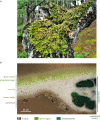The Lichens' Microbiota, Still a Mystery?
- PMID: 33859626
- PMCID: PMC8042158
- DOI: 10.3389/fmicb.2021.623839
The Lichens' Microbiota, Still a Mystery?
Abstract
Lichens represent self-supporting symbioses, which occur in a wide range of terrestrial habitats and which contribute significantly to mineral cycling and energy flow at a global scale. Lichens usually grow much slower than higher plants. Nevertheless, lichens can contribute substantially to biomass production. This review focuses on the lichen symbiosis in general and especially on the model species Lobaria pulmonaria L. Hoffm., which is a large foliose lichen that occurs worldwide on tree trunks in undisturbed forests with long ecological continuity. In comparison to many other lichens, L. pulmonaria is less tolerant to desiccation and highly sensitive to air pollution. The name-giving mycobiont (belonging to the Ascomycota), provides a protective layer covering a layer of the green-algal photobiont (Dictyochloropsis reticulata) and interspersed cyanobacterial cell clusters (Nostoc spec.). Recently performed metaproteome analyses confirm the partition of functions in lichen partnerships. The ample functional diversity of the mycobiont contrasts the predominant function of the photobiont in production (and secretion) of energy-rich carbohydrates, and the cyanobiont's contribution by nitrogen fixation. In addition, high throughput and state-of-the-art metagenomics and community fingerprinting, metatranscriptomics, and MS-based metaproteomics identify the bacterial community present on L. pulmonaria as a surprisingly abundant and structurally integrated element of the lichen symbiosis. Comparative metaproteome analyses of lichens from different sampling sites suggest the presence of a relatively stable core microbiome and a sampling site-specific portion of the microbiome. Moreover, these studies indicate how the microbiota may contribute to the symbiotic system, to improve its health, growth and fitness.
Keywords: Lobaria pulmonaria; lichen-associated bacteria; lichens; microbiome; omics; symbiosis.
Copyright © 2021 Grimm, Grube, Schiefelbein, Zühlke, Bernhardt and Riedel.
Conflict of interest statement
The authors declare that the research was conducted in the absence of any commercial or financial relationships that could be construed as a potential conflict of interest.
Figures






References
-
- Adams D. G., Bergman B., Nierzwicki-Bauer S. A., Rai A. N., Schüßler A. (2006). “Cyanobacterial-plant symbioses,” in The Prokaryotes, A Handbook on the Biology of Bacteria: Symbiotic associations, biotechnology, applied microbiology, 3rd Edn, Vol. 1 eds Dworkin M., Falkow S., Rosenberg E., Schleifer K. H., Stackebrandt E. (New York, NY: Springer; ), 331–363. 10.1007/0-387-30741-9_14 - DOI
Publication types
LinkOut - more resources
Full Text Sources
Other Literature Sources

